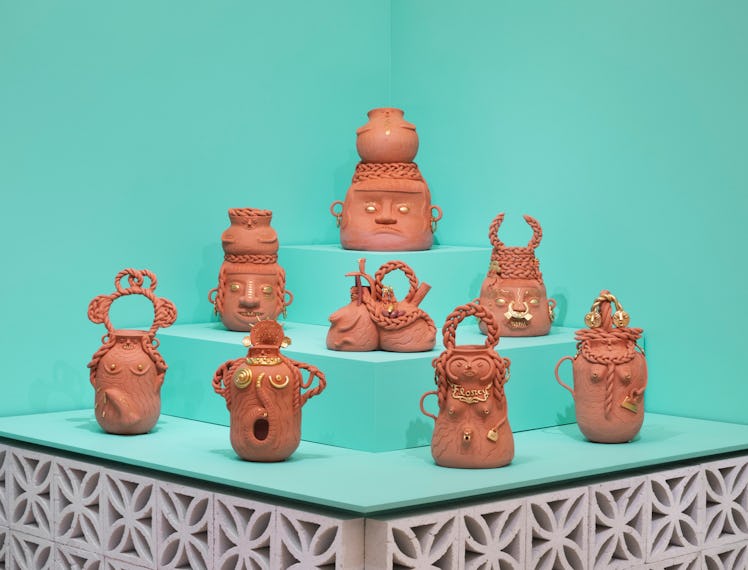When I first visited the Domesticanx exhibition at El Museo del Barrio in Harlem, I experienced something I don’t always feel at a museum. I was comfortable and at ease—how I feel when I’m at my tia’s house, or in the company of other close family members. That sort of kinship is part of the exhibition’s intention: Domesticanx brings together works from seven intergenerational artists in conversation about the home as a space for healing, spirituality, self-realization, and resistance.
The show, which runs through March 26 at the New York City museum, is based on the idea of domesticana, a concept created by the artist and scholar Amalia Mesa-Bains in the early 1990s. Domesticana expands upon the theory of rasquachismo, a concept within working-class Chicano communities that has to do with making the most with the least—it was first theorized by scholar and author Tomas Ybarra-Fausto. Domesticana confronts women’s suffering within patriarchal systems, and how women use the sphere of the domestic (decorative arts, healing traditions, home altar creations, and personal style) to break free from the domestic spaces to which they’re bound. The idea of cultural reclamation—revisiting the past to resurface values and rituals that might have been left behind—was a driving premise and radical political statement in the early Chicano Art Movement during the 1960s. At that time, however, the movement excluded most women and queer folks. It was also specific to the Mexican-American experience. Domesticanx opens the conversation up further to include people from various countries in Latin America.
Domesticana’s themes are still true today, but the way society defines womanhood has also evolved. Susanna Temkin, curator at El Museo, told me she aimed to interpret Mesa-Bain’s words in the context of present-day culture. “I happened upon a conversation between Amalia Mesa-Bains and Judy Baca. The conversation really stimulated me and I started to go back and read more of Amalia’s texts. When I got to ‘Domesticana,’ it stopped me in my tracks,” Temkin added. “Since the pandemic, I had been thinking about the experience of being in our homes, about taking care of ourselves, and valuing our families. I was thinking about women’s rights. I also felt like that conversation had expanded to include trans rights. So I wanted to bring in ideas of queerness to domesticana.”
Four of the artists featured in the show are making their museum debut with Domesticanx: Joel Gaitan, Cielo Félix-Hernández, Misla, and Amarise Carreras. Their work is placed alongside veteran artists including Nitza Tufiño, Maria Brito, and Mesa-Bains—a setup that reflects the nature of many Latin-American homes, where multiple generations live together.
“It’s crazy to be in dialogue with these artists who I’ve looked up to,” Félix-Hernández said (she’d just finished showing her work for the first time at the New Art Dealers Alliance Fair in Miami in December). She added that Tufiño, a Puerto Rican queer artist who was one of the first to donate works to El Museo, inspired how Félix-Hernández navigates the arts. “Domesticanx felt like being in a show with my own elders. It made me think about the conversations that we don’t get to have with our families,” she said. Her paintings in the show are influenced by her experience as a trans Puerto Rican woman—especially in terms of feeling othered in outside spaces and finding sanctuary within the home. (She illustrates the idea of safety by using architectural elements from her grandmother’s house in Puerto Rico.) Similarly, Gaitan uses breeze boxes like the ones in his grandmother’s house in Nicaragua to build a pyramid altar that holds eight ceramic sculptures. Misla combines memories of her family home with her living situation today—she and her partner have a place together—through large-scale multimedia paintings; Carreras’s photographs of carefully constructed altar-scapes pay homage to their past and queerness within their own family.
In order to fully understand the idea of domesticana, I met Mesa-Bains over Zoom in late November as she prepared for her retrospective, Archeology of Memory, opening February 4th at the UC Berkeley Art Museum and Pacific Film Archive. She described how the Latino emphasis on family is the subtext of domesticana. “There is a sacred nature to the home place, a special quality in those domestic moments and in the objects,” she said. “That is where I think the art comes from: it’s the identification of objects and the repositioning of them within the domestic life that calls up domesticana—which is now domesticanx.” Mesa-Bains added that her own family’s narrative has been a way to interrogate her personal identity, history, and culture.
“The topics in Domesticanx revolve around what I consider the ‘x’ to be: gender, sexuality, and feminism,” she said. “These are things we didn’t get to take care of in my generation, that need to be dealt with now—so that you can still have your ancestors, your domestic space, your belonging, because that’s what the family and the home place is about. The power of this exhibition is that it says, whatever form you live in, whatever choices you make, you are still in this family.”
